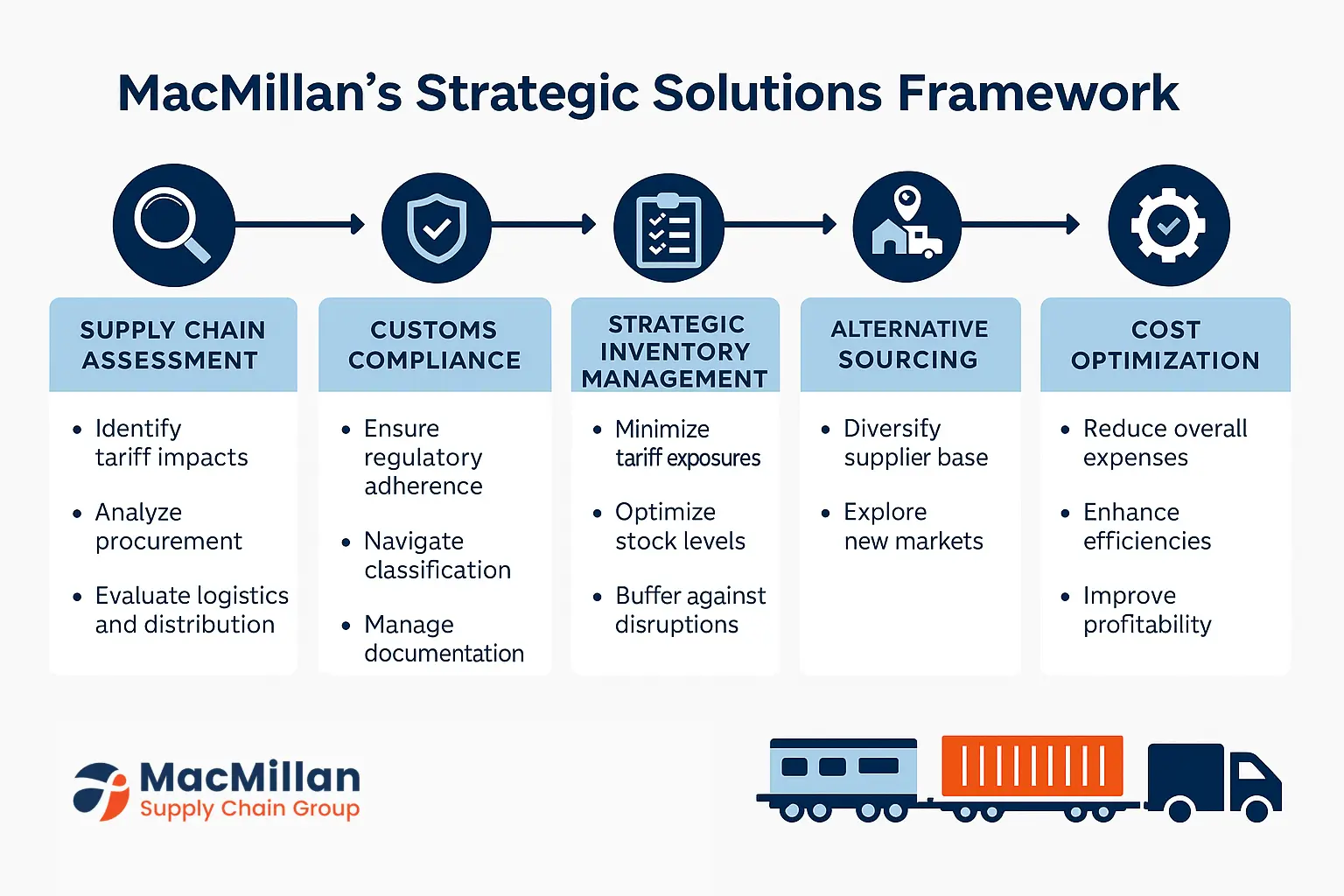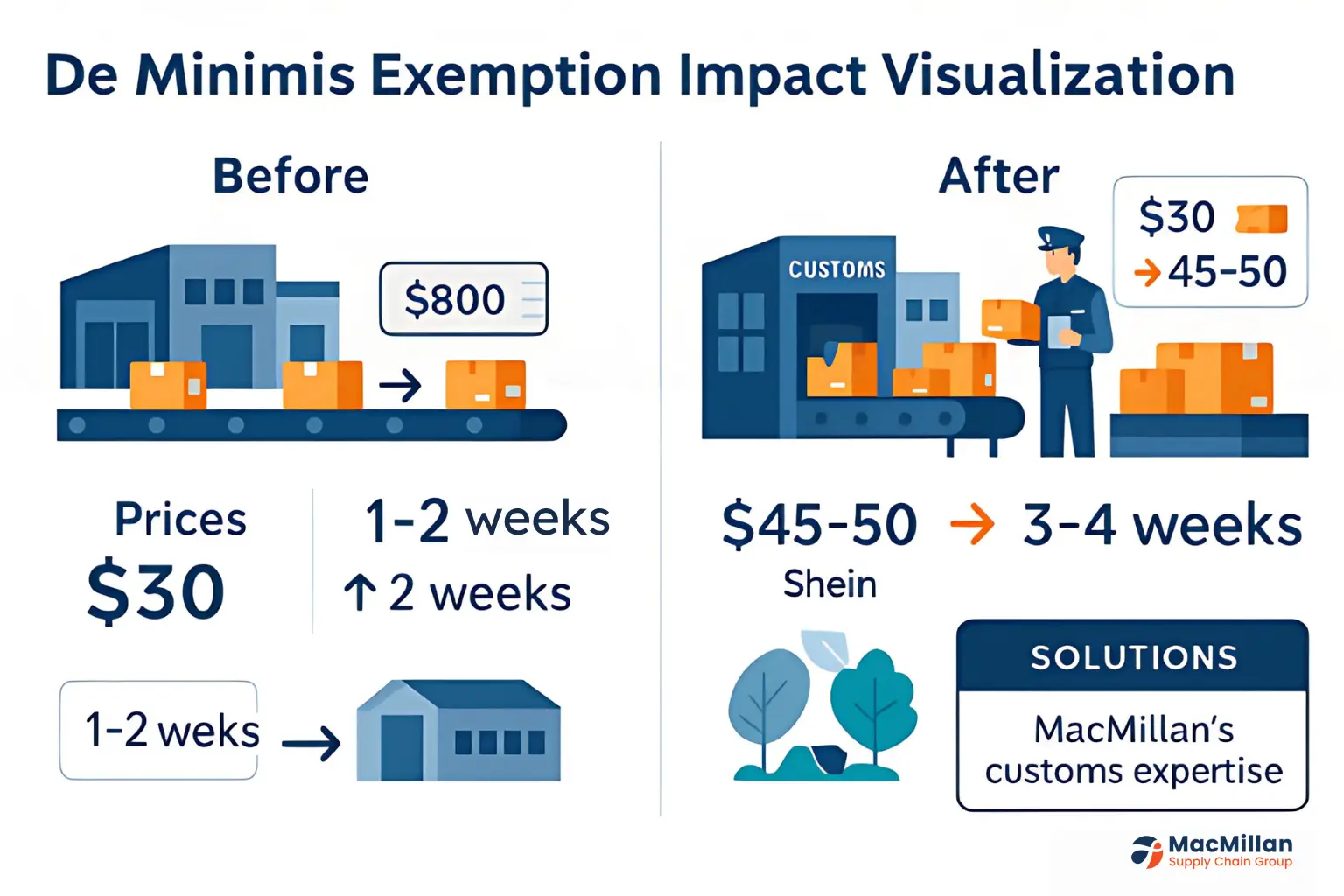De Minimis Removal 2025: What It Means for Canadian Cross-Border E-Commerce
The Trump administration’s removal of the de minimis exemption for Chinese goods on May 2, 2025, is causing a massive upheaval in the cross-border e-commerce environment between the United States and Canada. This legislative change impacts supply chains across North America, especially for Canadian companies that depend on international commerce. Though the regulation reform is initially directed at China, it signals broader changes that could affect all exports into the US market—including those from Canada.
How Canadian Logistics Firms Can Benefit from the 2025 De Minimis Removal
The disruption presents an opportunity for Canadian logistics firms like Macmillan SCG to act as strategic intermediaries. Canada’s location and trade connections make it a favorable collection and consolidation hub as Chinese exporters seek middle-tier nations still eligible for tariff exemptions.
“The de minimis exemption still applies to non-China origins,” said Gabriel Wildau, a China specialist at Teneo. He predicts, “Chinese e-commerce retailers will increasingly use countries like Mexico and Canada as collection points for low-value packages.”
Canadian firms with warehousing capacity and logistics know-how can position themselves as vital consolidation hubs for rerouted Chinese goods.
How Macmillan SCG Helps Companies Navigate Tariff Transitions After De Minimis Changes
Macmillan SCG, a prominent Canadian supply chain company with an expansive warehouse network and last-mile delivery expertise, is uniquely positioned to help businesses adjust to the post–de minimis exemption landscape.
Expert Customs Compliance Support Post–De Minimis Removal
Our expert team monitors evolving regulations to help clients stay compliant and minimize costs. We assist with tariff classification, accurate valuation methods, and documentation preparation to reduce unnecessary expenses and ensure regulatory alignment.
Strategic Warehousing in Response to De Minimis Policy Shifts
Macmillan SCG offers warehousing solutions throughout Canada to support logistics network restructuring. These facilities act as consolidation points for rerouted or staged goods bound for the U.S. market.
Technology-Driven Supply Chain Visibility Amid 2025 Tariff Changes
In a regulatory environment marked by uncertainty, real-time tracking is vital. Our advanced visibility tools keep clients updated on shipment status, customs processes, and compliance issues—empowering proactive management.
Last-Mile Delivery Optimization Under New De Minimis Rules
As companies reconfigure supply chains, last-mile delivery remains a critical differentiator. Our proven expertise in this area ensures clients maintain competitive delivery timelines despite upstream disruptions.
Preparing for Future Tariff Expansions Beyond the 2025 De Minimis Removal
The 2025 exemption removal may only be the beginning. Canadian businesses must prepare for the potential extension of these restrictions to other nations—including Canada itself.
Tracking U.S. Policy Changes Post–De Minimis Removal
The decision to eliminate de minimis for China carries political weight. Though enforcement has faced logistical setbacks, the White House emphasized this as “a critical step” toward national security. Canadian companies must monitor developments closely.
 Building a Resilient Supply Chain After De Minimis Reform
Building a Resilient Supply Chain After De Minimis Reform
Adaptive supply chains are essential. This involves:
Diversifying suppliers and sourcing regions
Creating alternate transportation routes
Partnering with customs brokers in key markets
Implementing technology for full supply chain control
Modeling financial impacts from potential tariffs
These enhancements build resilience regardless of how trade policies evolve.
Exploring Alternative Markets to Reduce Tariff Exposure
While the U.S. remains vital, Canadian businesses should explore trade opportunities in other stable markets. Diversifying away from U.S.-China-centric models could reduce risk significantly.
Thriving in a Post–De Minimis Removal 2025 Trade Environment
The end of de minimis exemptions for Chinese imports marks a major turning point in U.S. trade policy. Although focused on China for now, the possibility of broader application introduces strategic urgency.
Partnering with supply chain experts like Macmillan SCG provides the infrastructure, knowledge, and flexibility needed to stay competitive. We help clients understand implications, formulate responses, and implement efficient logistics solutions.
To thrive in this evolving landscape, businesses must adapt quickly—with experienced partners who turn regulatory challenges into opportunities.
What Is De Minimis and Why Was It Removed in 2025?
The de minimis exemption allowed goods under $800 to enter the U.S. duty-free, streamlining customs and accelerating growth in direct-to-consumer shipping. Its 2015 increase from $200 to $800 fueled a fourfold rise in shipments, now exceeding 4 million per day.
On April 2, 2025, President Trump signed an Executive Order to eliminate the de minimis exemption for Hong Kong and China starting May 2, citing national security concerns—particularly China’s alleged role in the fentanyl crisis via abuse of de minimis channels.
Timeline: Key Events Leading to the 2025 De Minimis Removal
Feb 1, 2025: Trump announces intent to end de minimis for China
Feb 4, 2025: 10% tariff implemented on Chinese and Hong Kong goods
Feb 5, 2025: Temporary rollback due to USPS and customs backlog
Mar 4, 2025: Tariff increased to 20%
Apr 2, 2025: Trump finalizes plan, adds 34% reciprocal tariff on 60 countries
Apr 5, 2025: 10% baseline reciprocal tariff imposed globally (excluding China)
May 2, 2025: De minimis exemption officially removed for Chinese goods
Chinese goods now face either 120% tariffs or a flat postal fee of $100 per shipment, increasing to $200 in June.
Cross-Border Supply Chain Impacts of De Minimis Removal
Canadian businesses importing from China and shipping to the U.S. face tough choices. The change affects not just Chinese goods but hints at wider reform that could impact Canadian exports.
 How E-Commerce Operations Are Responding to De Minimis Elimination
How E-Commerce Operations Are Responding to De Minimis Elimination
Before the May 2 deadline, platforms like Temu and Shein adjusted early. Both raised prices in April, leading to buyer stockpiling. Temu saw 60% revenue growth, and Shein had a 38% sales spike. Logistics networks faced pressure as shipments surged.
Canadian companies using similar shipping models must watch these developments closely. The de minimis exemption’s removal—while currently limited to China—could soon affect all nations.
Reconfiguring Supply Chains After the 2025 Tariff Changes
Forward-looking companies are already acting. Temu and Shein are diversifying sourcing to Mexico and Southeast Asia and building U.S. warehouses. Canadian firms face decisions: absorb costs, restructure supply chains, or optimize logistics.
Options include:
Establishing or expanding U.S. warehouses
Shifting sourcing to countries with de minimis benefits
Partnering with experts like Macmillan SCG
Adjusting documentation and declared values to reduce compliance costs
Navigating Complex Compliance After De Minimis Exemption Ends
Though de minimis has ended, certain customs regulations have been waived, leading to enforcement inconsistencies. For Canadian companies, experienced partners are critical to managing these unclear standards.
Adapting Cost Structures to the Post–De Minimis Trade Landscape
Tariffs won’t always appear in price indices but affect consumers directly. Thin margins will tighten, and competitive pricing becomes more difficult. Businesses must reassess pricing, cut inefficiencies, or accept slimmer margins. Flexible supply chains will provide a competitive edge.
Follow us on LinkedIn for real-time tariff updates
FAQS
The de minimis exemption is a customs rule that allows shipments valued below a certain threshold to enter a country without paying duties or taxes. In the U.S., this threshold was $800, while in Canada it remains $150 CAD for most shipments and $40 CAD for commercial shipments. The recent "expiry" refers to policy changes that have effectively closed this loophole for many products, particularly those from China.
Tariffs on Chinese goods have increased dramatically, with some products facing combined rates of up to 145%. The exact increase depends on the product category, with electronics, textiles, and manufacturing components seeing the highest increases. These tariffs apply to goods that previously entered duty-free under the de minimis exemption.
Your orders are more expensive because these companies can no longer use the de minimis exemption to avoid tariffs. Shein customs fees and Temu shipping costs now include the duties and taxes they must pay to import goods, plus additional processing fees. These companies are passing some or all of these costs to consumers.
Experts predict the customs delays will continue for at least 6-12 months as systems adapt to the new volume of packages requiring formal customs clearance. During this adjustment period, cross-border shopping Canada shipments may take 2-3 times longer than before the de minimis exemption changes.
Yes, the duty-free threshold still exists but with significant limitations. Strategic shipment planning can help maximize legitimate use of remaining exemptions, but businesses should consult with customs experts like MacMillan Supply Chain Group to ensure compliance.
Yes, Canadian import duties must typically be paid before goods are released from customs. This creates cash flow challenges for many businesses. Some larger importers may qualify for deferred payment programs, which MacMillan can help establish.
While the most significant tariffs target Chinese goods, the de minimis exemption changes affect small packages from all countries. Additionally, the broader trade war escalation has led to tariff increases on goods from multiple countries, creating a complex global trading environment.
Forward-thinking Canadian businesses are diversifying suppliers, building larger inventory buffers, implementing dynamic pricing models, and partnering with 3PL providers like MacMillan Supply Chain Group to navigate the new customs landscape.
While policy changes are always possible, most trade experts believe the closure of the de minimis loophole represents a long-term shift in trade policy. Businesses should plan for these changes to remain in effect for the foreseeable future.
MacMillan Supply Chain Group offers comprehensive solutions including customs compliance expertise, strategic inventory management, alternative sourcing strategies, and cost optimization services. Our team has decades of experience navigating trade policy changes and can develop customized solutions for your specific business needs.

 Building a Resilient Supply Chain After De Minimis Reform
Building a Resilient Supply Chain After De Minimis Reform How E-Commerce Operations Are Responding to De Minimis Elimination
How E-Commerce Operations Are Responding to De Minimis Elimination